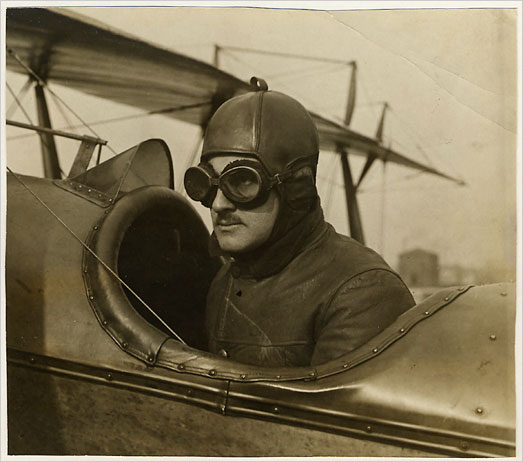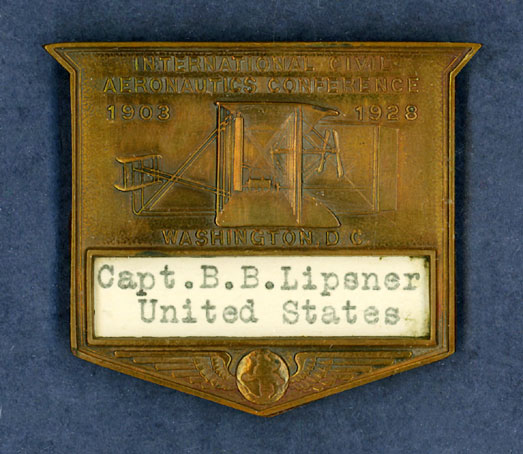Lipsner and the Army Signal Corps Service
(December 8 – July 15, 1918)

The material in this section relates to the first days of the Regular Air Mail Service. The Army Signal Corps was contracted by the Post Office Department to supply planes, pilots and mechanics for the first regular mail service between New York and Washington. The first plane left Washington for New York on 15 May 1918.
Lipsner was present that day as a Captain in the lubrication division of the Signal Corps. He took a leave of absence to work exclusively with the mail service. On 15 July 1918, the Service was turned over to the Post Office Department and Lipsner resigned his army commission to accept the civilian position of Superintendent of the Service.
Folder 1.
Seven (7) photographs of first flight, 15 May 1918
Flight report from pilot J. C. Edgarton, Philadelphia to New York leg, 15 May 1918
Folder 2.
Cover bearing 24-cent stamp, flown on first flight, 15 May 1918, with comments by Lipsner
Cover bearing 24-cent stamp, carried on 3 July 1918 New York to Boston test flight with comments by Henry Woodhouse of the Aerial League of America
Two (2) Covers bearing 16-cent stamp, dated 15 July 1918, first day of air mail rate change from 24- to 16-cent – one to W. T. Robey, who purchased the original sheet of inverted Jenny airmail stamps; one signed by Lipsner and pilot Bob Shank
Folder 3.
Lipsner's letter requesting leave of absence from Army, 3 July 1918
Letter appointing Lipsner Superintendent, 2 July 1918
Four (4) telegrams:
1 appointing Lipsner to Signal Corps, 18 December 1918
1 from George Kelly, 29 January 1918, regarding a mechanic
2 regarding Lipsner's resignation from Army
Folder 4.
Aerial Age Magazine, sent on June 3, 1918 on New York to Boston test flight with eleven 24-cent air mail stamps, with comments by Henry Woodhouse
Lipsner and the Civilian Air Mail Service
(August 12 – December 5, 1918)

On 12 August 1918, all aspects of the regular Washington to New York air mail service had been transferred completely to the Post Office Department, ending its relationship with the Army. Lipsner was named first Superintendent of the Service and became responsible for its day to day operation.
The following material relates to events and personnel of the Air Mail Service under Lipsner's tenure.
Folder 5.
Notes, used by Lipsner in selecting pilots and crews
Schedule for first week of civilian service, including time, pilots and mail loads
Photo, plane taking off from College Park, Maryland on 12 August 1918 for first flight of the civilian service
Three (3) covers from 12 August 1918 flight; all with comments by Henry Woodhouse; one backdated 11 August 1918
Pamphlet reporting arrival times for the regular Washington to New York Service during September 1918
Folder 6.
Photo of Lipsner handing American flag (see 3-D material) to pilot Max Miller, 28 November 1918
Photo of Lipsner and Major Cushman A. Rice and American flag
Notes written by Miller concerning the flag
Letter from Max Miller, addressing the need for emergency landing fields between New York and Chicago
Letter to General Superintendent of the South Park Commissioners in Chicago regarding a permit for a landing field at Grant Park
Permit from South Park Commissioners for landing field, dated 30 October 1918 newspaper articles concerning Lipsner's resignation as superintendent
The New York to Chicago Pathfinder Flights
(September 5 – 10, 1918)

On 6 August 1918, the Post Office Department announced plans for a new Chicago extension to the existing New York to Washington route. Lipsner chose his two premier pilots, Eddie Gardner and Max Miller to establish a safe route.
Miller and Gardner turned the flights into a personal competition. They left on the morning of 5 September 1918 from Belmont Park, New York. Despite numerous delays and mechanical failures, the pilots and the mail arrived safely in Chicago on 8 September. Lipsner and Assistant Postmaster General Otto Prager closely followed the flights from telegrams sent from Chicago, New York and the refueling sites in Lockhaven, Pennsylvania and Cleveland and Bryan, Ohio. Miller landed in New York on 10 September, a day after Gardner.
The following folders contain many of the original telegrams sent between Lipsner in Chicago, Praeger in Washington and the contacts at the refueling sites between 4 and 11 September 1918.
Folder 7.
Eleven (11) telegrams from 4 September 1918
Folder 8.
Thirteen (13) telegrams from 5 September 1918
Two (2) covers flown on first leg of flights, with comments by Woodhouse and signed by Gardner, Lipsner, Miller and Augustus Post
Folder 9.
Eighteen (18) telegrams from 6 September 1918
Folder 10.
Eight (8) telegrams from 7-10 September 1918
Cover, dated 9 September, flown on Chicago to New York trip
Mail Report from Gardner's one day return flight from Chicago to New York
Related to Pilots

This section of the collection contains miscellaneous items related to the pilots that worked under Lipsner.
Folder 11.
Two (2) telegrams concerning pilots refusal to fly in bad weather, leading to firing of Eddie Gardner and Bob Shank
Letter and cover from pilot H. Knox Martin, concerning his dismissal from the service for intoxication
Two (2) letters and 1 cover from Eddie Gardner to his sister
Photo reproduction of Max Miller, signed
Photograph of E. Hamilton Lee, signed
Letter from Eddie Gardner concerning his dismissal from the Air Mail Service
Life After the Air Mail Service
(after December 7, 1918)

Due to a number of disagreements with Second Assistant Postmaster Otto Praeger, Lipsner resigned his position as Superintendent on 6 December 1918. Throughout the rest of his life, however, he continued to be involved in preserving the memories of his 111 days in the service.
The following folders contain material from a sampling of the aviation-related events Lipsner participated in before his death on 24 December 1971.
The International Civil Aeronautics Conference, Washington D.C. (December 1928)

Folder 12.
Seven (7) first day covers from the Conference, signed by attendees, including Lipsner, Orville Wright, Amelia Earhart, James Edgarton and Bob Shank
Folder 13.
Two (2) sheets of 36 stamps (U.S. Scott Number 194), each tab (8) signed by Orville Wright
Folder 14.
Lipsner's souvenirs from the Conference, including membership card #265; ferry tickets for day trip to Kitty Hawk, North Carolina; Lipsner's nametag and guest ribbon; conference pamphlet and a Conference program signed by Orville Wright
Folder 15.
Photo, Wilbur Wright
Photo, Orville Wright, autographed by Orville Wright
Aeronautic Events
Folder 16.
Around-the-world letter to Lipsner from Chicago Mayor Martin Kennely dated 1 December 1953
Newspaper article concerning event (letter sent around the world from Chicago and back by air)
Four (4) covers carried in around-the-world flight, postmarked in Chicago, Paris and Tokyo
Folder 17.
Letter to Lipsner from Merrill Meigs concerning dedication of new airport dated 5 July 1950
Airport dedication cover dated 30 June 1959
Folder 18.
Cover with cachet commemorating Chicago to Mexico flight, dated 1 October 1928
Folder 19.
Letter to Lipsner from Second Assistant Postmaster General Paul Aiken concerning helicopter/pigeon race from Brookfield to Chicago, Illinois
Paper carried by pigeon bearing postmark from Brookfield dated 6 October 1949
Honors
Folder 20.
Photo, Winged America Trophy received by Lipsner, backing for Air Mail Pioneer Award, given to Lipsner by the Aerial League of America, 19 August 1939
Cover with cachet commemorating Lipsner's 33rd Anniversary as Superintendent dated 15 July 1951
Oversized and 3-Dimensional Objects
Dispatch Board, designed and used by Lipsner to keep track of planes, pilots, weather conditions, arrivals and departures
Mail Sack, carried by PMG Summerfield from Washington to Chicago
Mail Pouch, used on first helicopter mail flight, 20 August 1949
Flight suit, worn by Douglas Fairbanks and later by Gardner on all flights, also helmet, face mask, leggings, goggles and case
Bronze badge worn by Lipsner on Kitty Hawk Pilgrimage, 1928
One of Lipsner's original exhibit panels
Route Map, New Jersey, 1918
Silk flag carried aboard numerous flights
Two (2) placards from silent film, "The Air Mail"
Flight Record log, Max Miller
